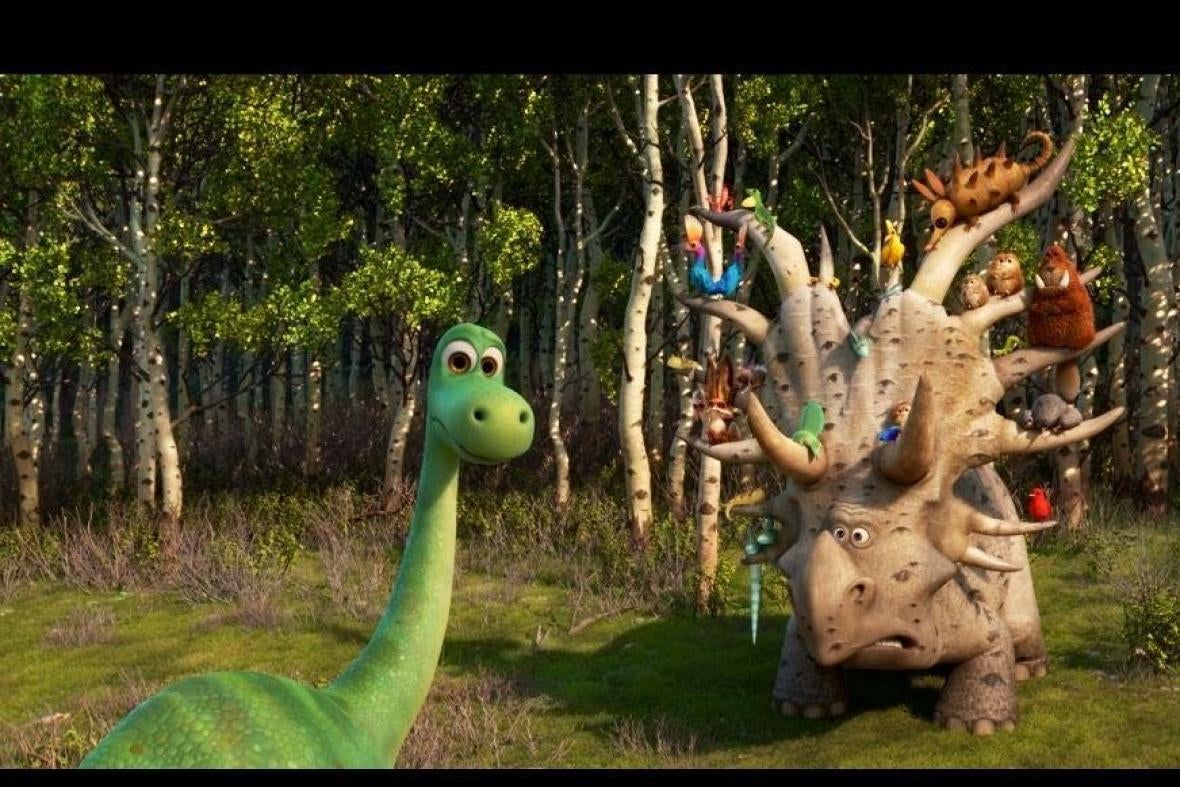The Good Dinosaur is a weird little movie. Despite the animated film’s immense budget and the sweeping vistas of Idaho, Wyoming, and Utah that serve as the backdrop for the alternate history tale, it’s really a small, simple story of “a boy and his dog,” only this time the boy is a dinosaur and the dog is a boy. All the plot points will be familiar to anyone who has watched The Lion King, Finding Nemo, Old Yeller, or White Fang, yet the familiar elements manage to come together well in this dinosaurian mashup of a well-worn yarn.
But there was one fundamental aspect of The Good Dinosaur that kept grating against the scientifically focused part of my brain. The movie’s opening conceit is that the mass extinction of 66 million years ago never happened. The massive asteroid that sparked the great die-off missed, and so the reign of the nonavian dinosaurs continued unabated. Pixar basically bought itself another 66 million years of evolutionary history to play with and then it squandered the opportunity.
There are plenty of paleontological nitpicks to be made about the movie. Poor Arlo, our herbivore dinosaur hero, was given forelimbs that bend the wrong way, in the opposite direction from every other dinosaur and four-limbed vertebrate that has ever lived. And while I can get that the move was done for aesthetics, the way the Tyrannosaurus cowboys gallop borders on disturbing. The carnivores keep their torsos stiff as the rest of their body bounds along, almost as if they’re riding mounts which happens to be themselves. The list could go on, to which the natural and reasonable response would be “It’s just a children’s movie!” But I still can’t shake the feeling of disappointment that Pixar decided to give us goofy, cartoonish versions of dinosaurs based on outdated notions from the 20th century, rather than actually playing out the consequences of the world it created.
The movie’s mammals underscore the problem. Hiding in the nooks and crannies of The Good Dinosaur’s world are little fuzzballs that don’t belong to any known species. They’re supposed to be new critters that evolved under the claws of the dinosaurs. This fits what we would expect if Arlo’s kind stayed large and in charge for another 66 million years. Even though mammals during the real Age of Dinosaurs diversified into an array of forms similar to today’s flying squirrels, beavers, anteaters, and more, the largest, Repenomamus, was only the size of a badger. And while the movie applies this effect unevenly—humans would never have evolved if dinosaurs remained dominant—the novel minibeasts Pixar created for The Good Dinosaur are a fun extension of the film’s setup. So why weren’t the same evolutionary consequences applied to the dinosaurs?
The Good Dinosaur’s major characters bear more resemblance to the giant models the Sinclair Oil Company floated down the Hudson for the 1964 World’s Fair than what paleontologists currently know about the creatures. Arlo and his family are variations on the standard “Brontosaurus” body plan, the eccentric collector Forrest Woodbush is a Styracosaurus, Butch and his family are Tyrannosaurus, and so on. So even though mammals have continued to adapt and evolve during the 66 million years of this alternate history, dinosaurs have either stagnated or reverted to previous body types while becoming smarter. Unfortunately, we never meet a dinosaurian naturalist to explain what the heck is actually going on.
As far as I can tell, evolutionary imagination was sacrificed in favor of nostalgia. This is obvious from the opening scene. Long-necked sauropods sprawl in a Cretaceous bog, lazily chewing soft vegetation as they slowly raise their necks from the quagmire. Given that Pixar is currently back under the Disney umbrella, this has to be a callback to Fantasia or the ExxonMobil-sponsored Universe of Energy ride in Epcot Center, which I badgered my parents to take me to see the moment I first stepped foot in Disney World. Even though Pixar movies are ostensibly for today’s kids, they’re shaped by the experiences of their parent’s generation, and that includes dopey-looking dinosaurs.
Maybe the creators of The Good Dinosaur decided that inventing new dinosaurs, as they should have done, would be too jarring. They may have thought that we can only recognize dinosaurs as what they were, but not think of them as real animals subject to evolutionary pressures just like every other organism. (And maybe that has something to do with why the uber-religious are ruffled by the fact that birds are living dinosaurs.) But imagine the world Pixar could have created. We now know that many dinosaurs—even the fearsome tyrannosaurs—had fluffy plumage. Given how many of the movie’s dinosaurs worry about the onset of winter, wouldn’t it have made sense for them to evolve downy coats to help insulate them from the biting chill of the high Western plains? Or, given all the farmwork involved in the movie, why not have descendants of Velociraptor-like dinosaurs that evolved to use claw and beak to make tools the way some crows do today?
I don’t know why Hollywood is afraid of the new dinosaurs and feathered dinosaurs in particular. This isn’t unique to The Good Dinosaur. We’ve been told that the dinosaurs of Jurassic World couldn’t be brought into accord with science because it’d break continuity, even though it would have been easy enough to write a scientist explaining how bird DNA had replaced frog genes to plug all those holes in the de-extinction process. And now we have The Good Dinosaur, whose only feathery dinosaurs are a pack of hillbilly raptors who make Cletus the Slack-Jawed Jokel look like subtle satire by comparison. I don’t understand the impulse or the reasoning that dinosaurs must always serve nostalgia first. Some of them are still here, continuing to change as they flit about our world, but in film we seem to be more comfortable relegating them to the fetid swamps of childhood memory.
The Good Dinosaur Should Have Let Dinosaurs Evolve

Courtesy of Disney/Pixar
Advertisement